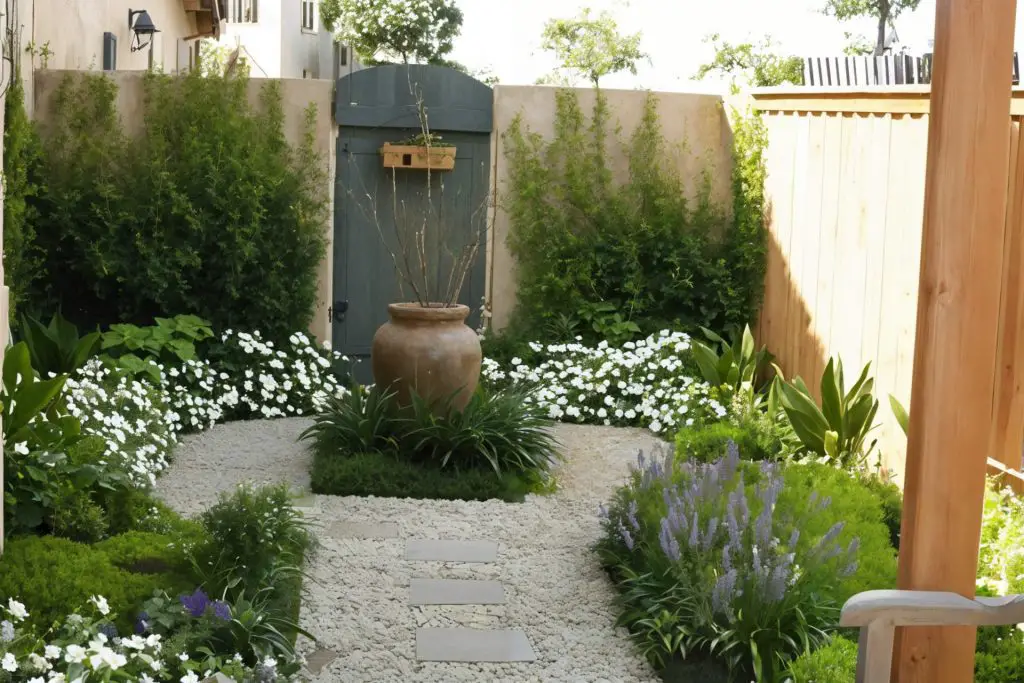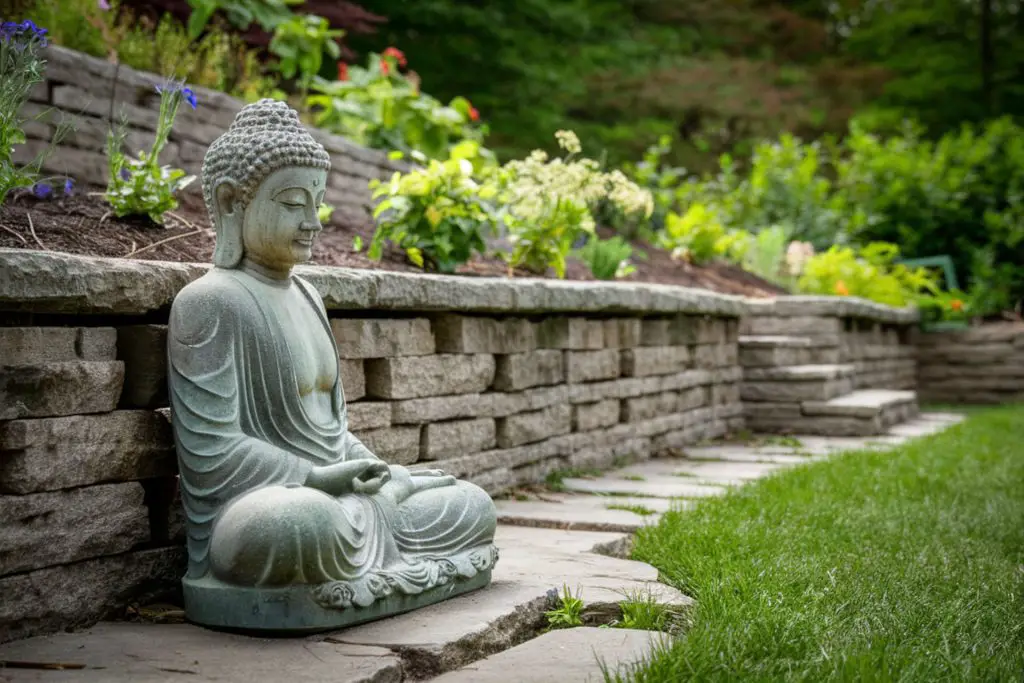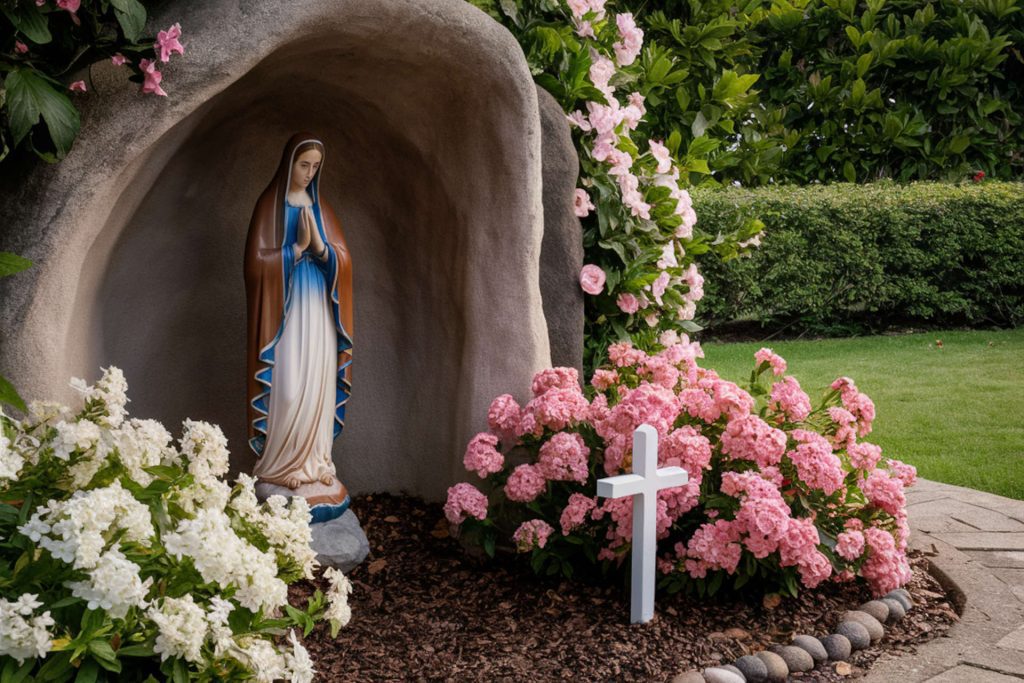Nurturing the Soul: Introducing the Concept of a Spiritual Garden
As I stepped off of the path at the back of the house and into what Jennifer called her spiritual space, the soft rustle of leaves and gentle chirping of birds enveloped me in a sense of calm. I had found myself rushing through the day, on autopilot, and completely out of touch with myself. It was then that I craved a quiet escape, a place to reconnect and find some solace.
As I sat down on the bench it was as if the world outside had melted away, leaving only the gentle whispers of nature. In that moment, I knew I had stumbled upon something profound – a sacred space where the boundaries between self and nature blurred, and the soul could breathe a sigh of relief
Nature has always held a special place in my heart. There’s something undeniably calming about the sound of leaves in the breeze, outside air on your skin and the gentle flow of a stream. A realisation that I have a urgent need to create by own quiet space where and could let nature wash over me and allow me to be at one with myself.
The Essence of a Spiritual Garden

A spiritual garden is more than just a beautifully landscaped space – it’s a sacred haven that nurtures the soul, calms the mind, and inspires the heart. It’s a personal sanctuary where one can escape the chaos of everyday life and connect with nature on a deeper level. Imagine stepping into a serene space, surrounded by lush greenery, vibrant flowers, and the soothing sounds of nature. As you breathe in the fresh air, feel the tension in your body begin to melt away, replaced by a sense of calm and tranquility.
A spiritual garden is a space that invites introspection, reflection, and contemplation. It’s a place where you can quiet the mind, listen to your heart, and tap into your inner wisdom. It’s a space that encourages you to slow down, breathe deeply, and reconnect with the natural world. As you wander through the gardens, you may find yourself drawn to a particular plant or feature that speaks to your soul. Perhaps it’s the gentle rustle of bamboo, the vibrant colors of a butterfly garden, or the soothing sounds of a water feature. Whatever it may be, your spiritual garden is a reflection of your inner world, a manifestation of your deepest desires, hopes, and dreams.
Key Elements:
- Peace and Serenity: The ambiance of a spiritual garden is designed to evoke calmness and tranquility. Features such as soft rustling leaves, soothing water fountains, and gently swaying grasses contribute to a serene atmosphere.
- Personal Space: A spiritual garden provides a private refuge for quiet moments. This space can be used for meditation, reading, or simply sitting and enjoying the garden’s tranquility.
As you create your spiritual garden, remember that it’s a sacred space that’s uniquely yours. It’s a place where you can express yourself freely, without judgment or expectation. It’s a space that evolves with you, growing and changing as you do. And as you tend to your garden, you’ll find that you’re not just nurturing the plants – you’re nurturing your own soul.
“Nature is not a place to visit. It is home.” – Gary Snyder
Gary Snyder (American poet, lecturer, and environmental activist)
Starting Your Sanctuary: A Gentle Beginning
The idea of creating a spiritual garden might seem daunting at first. But remember, even the most magnificent gardens began as a single seed. Don’t be discouraged if you don’t have acres of land or a hefty budget. The beauty lies in starting small and allowing your sanctuary to evolve with you.
Perhaps begin with a single potted plant on a sunny windowsill. A fragrant herb like rosemary or calming lavender can add a touch of life and serenity to your space. As your confidence grows, you can expand your haven, adding elements that resonate with your spirit.
The key is personalization. This could involve incorporating objects that inspire you – a favorite quote etched on a stone, a religious symbol that brings you comfort, or even a small wind chime that fills the air with gentle music. Remember, your spiritual garden is a reflection of your inner world. Let it be a space that speaks to your soul.
Most importantly, embrace the process. A spiritual garden, is not a destination, but is always evolving. This will usually lead to continuous exploration of the space you have created in order that it will consistently foster the peace and connection you need for your soul as you travel through life. It should be a space that changes with your needs and reflects your ever-changing spirit. So, take a deep breath, get your hands dirty, and embark on the journey of cultivating your very own sanctuary.
Designing a Spiritual Garden

When designing a spiritual garden, the possibilities are endless. There’s no one-size-fits-all approach, as every garden is a unique reflection of your soul. Irrespective of space whether a small balcony, a backyard, or a community garden, the key is to create a space that resonates with your inner world.
One of the most beautiful aspects of spiritual garden design is its flexibility. You can incorporate personal elements that hold meaning for you, such as a statue of a spiritual leader, a wind chime that resonates with your energy, or a plant with symbolic significance. You might choose to create a meditation circle, a labyrinth, or a serpentine path that invites contemplation. The possibilities are endless, and the most important thing is to listen to your intuition and create a space that feels authentic to you.
Elements to Consider:

Plants:
This is a huge topic that we will explore in greater detain in other articles. In essence though, choose plants that resonate with you, such as aromatic herbs, flowering shrubs, or evergreens, which offer year-round structure.
Consider including plants with spiritual or cultural significance, such as sage or lavender, for their calming properties. Varieties with varied heights and textures, from tall grasses to low-lying mosses, can add depth to the garden’s design.
Seating:
If you are intending to spend extended periods in your spiritual garden then seating will be an important element. The incorporation of comfortable seating, like benches or lounge chairs creates a more inviting space for reflection or meditation.
Choose materials that complement the garden’s style, such as wooden benches for a natural look or metal chairs for a modern aesthetic. Ensure the seating is placed in peaceful spots, away from potential distractions.
Features:
Enhance the atmosphere with water fountains, statues, or wind chimes, offering both visual and auditory stimuli. Water features like fountains or small streams can create soothing sounds, while sculptures or statues can reflect personal beliefs or themes. Wind chimes, bells, or other sound elements can add gentle, melodic notes, enhancing the overall ambiance.
Some design elements to consider when creating your spiritual garden include:
- Water features: Incorporate a small streams, a pond, fountain, or birdbath to create can create soothing sounds and a calming atmosphere.
- Statues or sculptures: Statues can reflect personal beliefs or themes. Have a statue of a spiritual leader, a Buddha, the Virgin Mary, a grotto or a nature-inspired sculpture that resonates with your personal beliefs and energy.
- Sounds: Add gentle, melodic notes, enhancing the overall ambiance. Wind chimes, bells, or other sound elements can add gentle, melodic notes, enhancing the overall ambiance.
- Personal elements: Incorporate personal items that hold meaning for you, such as a favorite quote, a piece of artwork, or a sacred object.
The Benefits of a Spiritual Garden

Clearly, a spiritual garden has to offers more than just aesthetic appeal; it should provide substantial benefits for your well-being, your soul , as well as fostering a connection to nature.
Well-Being:
- Stress Reduction: Spending time in a spiritual garden can significantly reduce stress, offering a peaceful retreat from daily pressures. The calming ambiance, soothing sounds, and natural elements promote relaxation, helping to quiet the mind and ease tension.
- Mindfulness: The garden’s tranquil environment encourages mindful practices, such as meditation, yoga, or simply sitting in quiet contemplation. These activities promote emotional well-being by allowing individuals to focus on the present moment and reconnect with their inner selves.
Connection to Nature:
- Grounding: A spiritual garden fosters a connection to the natural world, grounding individuals in their surroundings. The act of gardening itself, from planting to pruning, can create a tangible link to the earth, cultivating a sense of balance and harmony.
- Environmental Awareness: Spending time in a spiritual garden can also heighten one’s awareness of the environment. Observing the cycles of nature, from blooming flowers to changing seasons, can foster a deeper appreciation for the interconnectedness of all living things.
Practical Tips
Creating a spiritual garden is a rewarding project that can begin with simple steps. Here are practical tips for crafting and maintaining your own retreat:
Getting Started:
- Location: If you are fortunate to have a choice, choose a spot that offers privacy and tranquility, whether it’s a corner of your backyard or a secluded balcony. Consider factors like sunlight, shade, and access to water, ensuring the chosen location suits your needs and plants.
- Simple Steps: Start small, perhaps with a few potted plants or a seating area, and build gradually. Introduce elements that resonate with you, from fragrant flowers to soothing water features.
Sustaining the Garden:
- Maintenance: Regularly tend to your garden, including watering, pruning, and weeding, to keep it thriving. Incorporate practices like mulching or composting to nourish the soil and support healthy plant growth.
- Spiritual Nourishment: Beyond physical upkeep, visit your garden frequently, allowing its peaceful ambiance to foster mindfulness and relaxation. Use it as a space for meditation, yoga, or simply enjoying quiet moments.
Creating a spiritual garden is an evolving process, offering both immediate and long-term benefits. When I stepped into Jennifer’s spiritual garden my perception of what I wanted a garden to be completely changed. By starting small and building gradually, like me, you can cultivate a unique, personalized retreat that supports both your mental and spiritual well-being.
